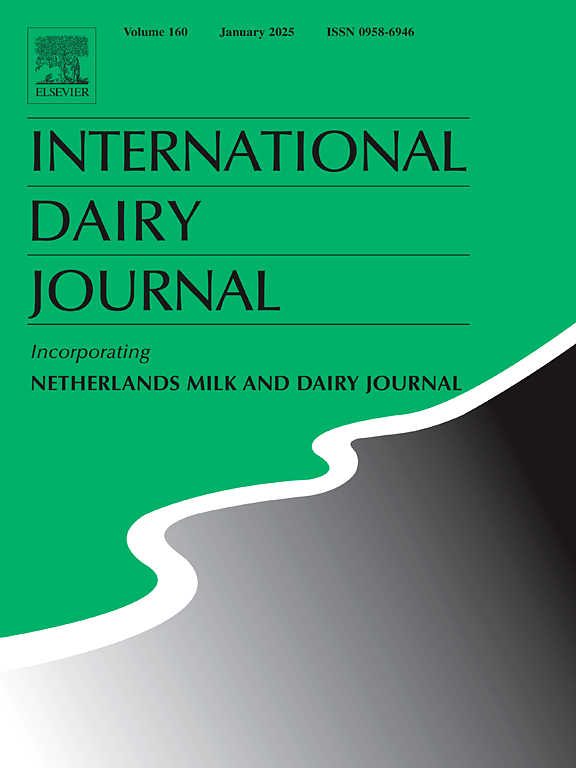The macronutrient composition of breas tmilk from Mexican mothers in the first six months postpartum: Influence of maternal factors and potential effects on infant anthropometry
IF 3.1
3区 农林科学
Q2 FOOD SCIENCE & TECHNOLOGY
引用次数: 0
Abstract
The relationship between maternal obesity, age, and the macronutrient concentrations in breast milk is unclear. This study aimed to investigate whether the macronutrient composition of breast milk is influenced by maternal adiposity and age, as well as how these factors impact infant growth during the first six months of life. The concentrations of lipids, proteins, and carbohydrates in colostrum, transition milk, and mature milk were measured in samples from 118 mothers. The total body fat (TBF) was determined, and mothers were categorized as adequate (ATBF, ≤30 %) or elevated (ETBF, >30 %) and further classified by age as younger (less than 30 years) or older (more than 30 years). Infant anthropometric measurements were also taken. The concentrations of all macronutrients in mature breast milk were significantly higher (p < 0.05) in the ETBF and older mother groups compared to the ATBF and younger groups. Maternal age was positively associated (R2 = 0.099, p = 0.034) with the concentration of lipids in colostrum. There was a negative correlation (p < 0.05) between macronutrient levels and the infant's weight and head circumference in the ATBF group. Maternal adiposity and age were linked to higher levels of macronutrients in mature breast milk. These levels were found to be greater in mature breast milk compared to colostrum, but this was only observed in women under 30 years old. Low levels of macronutrients in breast milk were associated with increases in infants' weight and head circumference, only in lean mothers.
墨西哥母亲产后6个月母乳中的常量营养素组成:母体因素的影响及其对婴儿人体测量的潜在影响
母亲肥胖、年龄和母乳中常量营养素浓度之间的关系尚不清楚。本研究旨在探讨母乳中的常量营养素组成是否受到母亲肥胖和年龄的影响,以及这些因素如何影响婴儿在生命的前六个月的生长。对118位母亲的初乳、过渡乳和成熟乳中的脂质、蛋白质和碳水化合物浓度进行了测量。测定总体脂(TBF),将母亲分为充足(ATBF≤30%)或升高(ETBF > 30%),并进一步按年龄划分为年轻(小于30岁)或年长(大于30岁)。还对婴儿进行了人体测量。成熟母乳中所有常量营养素的浓度均显著升高(p <;与ATBF组和年轻组相比,ETBF组和年长母亲组的差异为0.05)。母体年龄与初乳脂质浓度呈正相关(R2 = 0.099, p = 0.034)。两者呈负相关(p <;ATBF组宏量营养素水平与婴儿体重和头围之间的差异(0.05)。母亲的肥胖和年龄与成熟母乳中较高水平的宏量营养素有关。与初乳相比,成熟母乳中的这些水平被发现更高,但这只在30岁以下的女性中观察到。母乳中常量营养素含量低与婴儿体重和头围的增加有关,只有在瘦弱的母亲中才如此。
本文章由计算机程序翻译,如有差异,请以英文原文为准。
求助全文
约1分钟内获得全文
求助全文
来源期刊

International Dairy Journal
工程技术-食品科技
CiteScore
6.50
自引率
9.70%
发文量
200
审稿时长
49 days
期刊介绍:
The International Dairy Journal publishes significant advancements in dairy science and technology in the form of research articles and critical reviews that are of relevance to the broader international dairy community. Within this scope, research on the science and technology of milk and dairy products and the nutritional and health aspects of dairy foods are included; the journal pays particular attention to applied research and its interface with the dairy industry.
The journal''s coverage includes the following, where directly applicable to dairy science and technology:
• Chemistry and physico-chemical properties of milk constituents
• Microbiology, food safety, enzymology, biotechnology
• Processing and engineering
• Emulsion science, food structure, and texture
• Raw material quality and effect on relevant products
• Flavour and off-flavour development
• Technological functionality and applications of dairy ingredients
• Sensory and consumer sciences
• Nutrition and substantiation of human health implications of milk components or dairy products
International Dairy Journal does not publish papers related to milk production, animal health and other aspects of on-farm milk production unless there is a clear relationship to dairy technology, human health or final product quality.
 求助内容:
求助内容: 应助结果提醒方式:
应助结果提醒方式:


